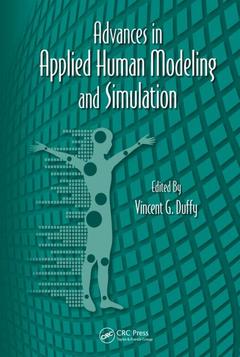Section I: Human Model Fidelity and Sensitivity; Chapter 1: Human Modeling and Simulation with High Biofidelity; Chapter 2: Sensitivity Analysis of Achieving a Reach Task Considering Joint Angle and Link Length Variability; Chapter 3: Probabilistic and Simulation-Based Methods for Study of Slips, Trips, and Falls-State of the Art; Chapter 4: Helmet Risk Assesment for Top and Side Impact in Construction Sectors; Chapter 5: Stochastic Optimization Applications for Robotics and Human Modeling; Section II: Problem Solving Applications; Chapter 6: Service Management System Based on Computational Customer Models Using Large-scale Log Data of Chain Stores; Chapter 7: Development of Database on Daily Living Activities for Realistic Biomechanical Simulation; Chapter 8: Social System Design Using Models of Social and Human Mind Networks-CVCA, WCA and Bayesian Network Modeling; Chapter 9: Promotion of Social Participation among the Elderly based on Happiness Structure Analysis using the Extended ICF; Chapter 10: Barcode Scanning Data Acquisition Systems in Temporary Housing Area to Support Victim Community; Section III: Problem Solving Applications; Chapter 11: Analysis of the Effect of an Information Processing Task on Goal-directed Arm Movements; Chapter 12: Cognitive and Affective Modeling in Intelligent Virtual Humans for Training and Tutoring Applications; Chapter 13: Intelligent Agents and Serious Games for the Development of Contextual Sensitivity; Chapter 14: Outdoor A ugmented Reality for Adaptive Mental Model Support; Section IV: Human Surface Scan, Data Processing and Shape Modeling; Chapter 15: Topology Free Automated Landmark Detection; Chapter 16: Geometric Analysis of 3D Torso Scans for Personal Protection Applications; Chapter 17: Shape Description of the Human Body Based on Discrete Cosine Transform; Section V: Student Models in Adaptive Modern Instructional Settings; Chapter 18: Personalized Refresher Training Based on a Model of Competency Acquisition and Decay; Chapter 19: Modeling Student Arguments in Research Reports; Chapter 20: Modeling Student Behaviors in an Open-ended Learning Environment; Chapter 21: Detailed Modeling of Student Knowledge in a Simulation Context; Chapter 22: Framework for Instructional Technology; Section VI: Advances in Modeling for User Centered Design; Chapter 23: Assessment of Manikin Motions in IMMA; Chapter 24: The Use of Volumetric Projection in Digital Human Modelling Software for the Identification of Category N 3 Vehicle Blind Spots; Chapter 25: The Use of DHM Based Volumetric View Assessments in the Evaluation of Car A-Pillar Obscuration; Chapter 26: Using Ergonomic Criteria to Adaptively Define Test Manikins for Design Problems; Chapter 27: Automatic Fitting of a 3D Character to a Computer Manikin; Chapter 28: Comparison of Algorithms for Automatic Creation of Virtual Manikin Motions; Chapter 29: An Algorithm for Shoe- Last Bottom Flattening; Section VII: Validation for Human Interaction in Various Consumer, Ground Transport and Space Vehicle Applications; Chapter 30: Occupant Calibration and Validation Methods; Chapter 31: Model for Predicting the Performance of Planetary Suit Hip Bearing Designs; Chapter 32: Integration of Strength Models with Optimization-Based Posture Prediction; Chapter 33: Effects of Changes in Waist of Last on the High-heeled In-shoe Plantar Pressure Distribution; Chapter 34: Fingertips Deformation under Static Forces: Analysis and Experiments; Chapter 35: The Arch Analysis with 3D Foot Model Under Different Weight-loading; Chapter 36: Multi-Scale Human Modeling for Injury Prevention; Chapter 37: Comparative Ergonomic Evaluation of Spacesuit and Space Vehicle Design; Chapter 38: Evaluation of the Enlarging Method with Haptic Using Multi-touch Interface; Chapter 39: Reconstruction of Skin Surface Models for Individual Subjects; Chapter 40: Effects of High Heel Shape on Gait Dynamics and Comfort Perception; Section VIII: Cognitive and Social Aspects: Modeling, Monitoring, Decision and Response; Chapter 41: Affective LED Lighting Color Schemes Based on Product Type; Chapter 42: Human Activity and Social Simulation; Chapter 43: Effects of the Order of Contents in the Voice Guidance When Operating Machine; Chapter 44: Framing the Socio-cultural Context to Aid Course of Action Generation for Counterinsurgency; Chapter 45: The vmStrat Domain Specific Language; Chapter 46: Decision Support System for Generating Optimal Sized and Shaped Tool Handles; Chapter 47: Ergonomic Work Analysis Applied to Chemical Laboratories on an Oil and Gas Research Center; Chapter 48: Evaluation of the Map for the Evacuation in Disaster Using PDA Based on the Model of the Evacuation Behavior; Section IX: New Methods and Modeling in Future Applications; Chapter 49: Diagrammatic User Interfaces; Chapter 50: A Study on Effect of Coloration Balance on Operation Efficiency and Accuracy, based on Visual Attractiveness of Color; Chapter 51: The Integration of Ethnography and Movement Analysis in Disabled Workplace Development; Chapter 52: Multi-Source Community Pulse Dashboard; Chapter 53: Development of a 3-D Kinematic Model for Analysis of Ergonomic Risk for Rotator Cuff Injury in Aircraft Mechanics; Chapter 54: Analysis of a Procedural System for Automatic Scenario Generation; Chapter 55: Motion Synthesizer Platform for Moving Manikins; Chapter 56: Human Engineering Modeling and Performance: Capturing Humans and Opportunities





